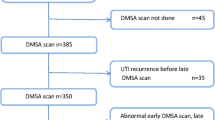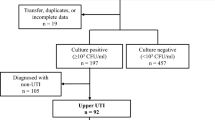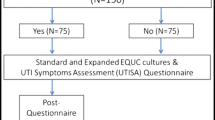Abstract
In their article which appears in this issue of Pediatric Nephrology, Dr. S. Swerkersson and co-workers claim that as many as one in every five infants with a true episode of urinary tract infection (UTI) will be missed with the commonly used cut-off level of ≥105 colony forming units (CFU)/mL. This controversial finding is supported by the results of seven previous studies including a total of 1587 children. Dr. E.H. Kass, who in the 1950s suggested the presently used cut-off level, knew at the time that it excluded a number of patients with a true infection. Later studies in adult patients also showed that up to 46–49 % of women with a likely diagnosis of cystitis had low bacterial counts. These findings can, if true, improve our understanding of cases of unexplained post-infectious renal scarring. Children with low bacterial counts during an acute infectious episode have a significant risk of receiving delayed or even no antimicrobial treatment. The results of scientific studies are also confounded if 20 % of the subjects with a true infection are wrongly included in a control group diagnosed as having no UTI due to low bacterial counts. This problem cannot be easily solved by lowering the cut-off level and generally accepting that any bacterial count signifies a “true” infection as this approach will drastically reduce the specificity of the culture result. Instead, as many as possible urine samples for culture should be collected from babies, infants and small children with a suprapubic bladder puncture, or a catheterised sample. In such samples bacterial counts as low as 103 CFU/mL are generally regarded as significant. In many cases, however, the only possibility is a “clean catch” or bag sample. In these situations, the treating physician needs to take all relevant clinical and laboratory parameters into account and if clinically important data support the diagnosis of a UTI not disregard this diagnosis based only on low bacterial counts. C-reactive protein or procalcitonin can, in a febrile child, help the physician differentiate between a febrile bacterial UTI and a viral infection. A positive nitrite test provides, albeit with a low sensitivity, strong support for a UTI diagnosis.
Similar content being viewed by others
References
Swerkersson S, Jodal U, Åhrén C, Sixt R, Stokland E, Hansson S (2015) Urinary tract infection in infants: the significance of low bacterial count. Pediatr Nephrol. doi:10.1007/s00467-015-3199-y
Kass EH (1962) Pyelonephritis and bacteriuria. A major problem in preventive medicine. Ann Intern Med 56:46–53
Stamm WE, Counts GW, Running KR, Fihn S, Turck M, Holmes KK (1982) Diagnosis of coliform infection in acutely dysuric women. N Engl J Med 307:463–468
Kunin CM, White LV, Hua TH (1993) A reassessment of the importance of “low-count” bacteriuria in young women with acute urinary symptoms. Ann Intern Med 119:454–460
Aronson AS, Gustafson B, Svenningsen NW (1973) Combined suprapubic aspiration and clean-voided urine examination in infants and children. Acta Paediatr Scand 62:396–400
Etoubleau C, Reveret M, Brouet D, Badier I, Brosset P, Fourcade L, Bahans C, Garnier F, Blanc P, Guigonis V (2009) Moving from bag to catheter for urine collection in non-toilet-trained children suspected of having urinary tract infection: a paired comparison of urine cultures. J Pediatr 154:803–806
Hansson S, Brandstrom P, Jodal U, Larsson P (1998) Low bacterial counts in infants with urinary tract infection. J Pediatr 132:180–182
Hoberman A, Wald ER, Reynolds EA, Penchansky L, Charron M (1994) Pyuria and bacteriuria in urine specimens obtained by catheter from young children with fever. J Pediatr 124:513–519
Kanellopoulos TA, Vassilakos PJ, Kantzis M, Ellina A, Kolonitsiou F, Papanastasiou DA (2005) Low bacterial count urinary tract infections in infants and young children. Eur J Pediatr 164:355–361
Koskimies O (1965) Diagnostic accuracy of urinary tract infection and subsequent development of renal scars. J Pediatr 126:157–159
Ramage IJ, Chapman JP, Hollman AS, Elabassi M, McColl JH, Beattie TJ (1999) Accuracy of clean-catch urine collection in infancy. J Pediatr 135:765–767
Wettergren B, Jodal U, Jonasson G (1985) Epidemiology of bacteriuria during the first year of life. Acta Paediatr Scand 74:925–933
Ammenti A, Cataldi L, Chimenz R, Fanos V, La Manna A, Marra G, Materassi M, Pecile P, Pennesi M, Pisanello L, Sica F, Toffolo A, Montini G, Italian Society of Pediatric Nephrology (2012) Febrile urinary tract infections in young children: recommendations for the diagnosis, treatment and follow-up. Acta Paediatr 101:451–457
Mori R, Lakhanpaul M, Verrier-Jones K (2007) Diagnosis and management of urinary tract infection in children: summary of NICE guidance. BMJ 335:395–397
Roberts KB (2011) Urinary tract infection: clinical practice guideline for the diagnosis and management of the initial UTI in febrile infants and children 2 to 24 months. Pediatrics 128:595–610
Coulthard MG, Lambert HJ, Keir M (1997) Occurrence of renal scars in children after their first referral for urinary tract infection. BMJ 315:918–919
Tullus K (2011) Difficulties in diagnosing urinary tract infections in small children. Pediatr Nephrol 26:1923–1926
Gervaix A, Galetto-Lacour A, Gueron T, Vadas L, Zamora S, Suter S, Girardin E (2001) Usefulness of procalcitonin and C-reactive protein rapid tests for the management of children with urinary tract infection. Pediatr Infect Dis J 20:507–511
Leroy S, Romanello C, Galetto-Lacour A, Bouissou F, Fernandez-Lopez A, Smolkin V, Gurgoze MK, Bressan S, Karavanaki K, Tuerlinckx D, Leblond P, Pecile P, Coulais Y, Cubells C, Halevy R, Aygun AD, Da Dalt L, Stefanidis CJ, Vander Borght T, Bigot S, Dubos F, Gervaix A, Chalumeau M (2011) Procalcitonin is a predictor for high-grade vesicoureteral reflux in children: meta-analysis of individual patient data. J Pediatr 159:644–651
Leroy S, Fernandez-Lopez A, Nikfar R, Romanello C, Bouissou F, Gervaix A, Gurgoze MK, Bressan S, Smolkin V, Tuerlinckx D, Stefanidis CJ, Vaos G, Leblond P, Gungor F, Gendrel D, Chalumeau M (2013) Association of procalcitonin with acute pyelonephritis and renal scars in pediatric UTI. Pediatrics 131:870–879
Montini G, Tullus K, Hewitt I (2011) Febrile urinary tract infections in children. N Engl J Med 365:239–250
Mori R, Yonemoto N, Fitzgerald A, Tullus K, Verrier-Jones K, Lakhanpaul M (2010) Diagnostic performance of urine dipstick testing in children with suspected UTI: a systematic review of relationship with age and comparison with microscopy. Acta Paediatr 99:581–584
Author information
Authors and Affiliations
Corresponding author
Ethics declarations
Conflict of interest
The author declares no conflict of interest.
Rights and permissions
About this article
Cite this article
Tullus, K. Low urinary bacterial counts: do they count?. Pediatr Nephrol 31, 171–174 (2016). https://doi.org/10.1007/s00467-015-3227-y
Received:
Accepted:
Published:
Issue Date:
DOI: https://doi.org/10.1007/s00467-015-3227-y




